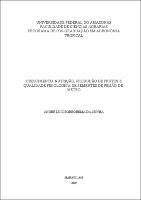| ???jsp.display-item.social.title??? |


|
Please use this identifier to cite or link to this item:
https://tede.ufam.edu.br/handle/tede/7195| ???metadata.dc.type???: | Tese |
| Title: | Crescimento, nutrição, produção de frutos e qualidade fisiológica de sementes de feijão-de-metro |
| ???metadata.dc.creator???: | Cunha, André Luiz Borborema da  |
| ???metadata.dc.contributor.advisor1???: | Chaves, Francisco Célio Maia |
| First advisor-co: | Kano, Cristiaini |
| ???metadata.dc.contributor.referee1???: | Rodrigues, Maria do Rosário Lobato |
| ???metadata.dc.contributor.referee2???: | Gentil, Daniel Felipe de Oliveira |
| ???metadata.dc.contributor.referee3???: | Cardoso, Marinice Oliveira |
| ???metadata.dc.contributor.referee4???: | Santos, José Zilton Lopes |
| ???metadata.dc.description.resumo???: | O rendimento da cultura do feijão-de-metro está ligado à sementes de alta qualidade fisiológica, que por sua vez, é a expressão do máximo poder germinativo e vigor. A obtenção de sementes com qualidade é condicionada há diversos fatores tais como, o estado nutricional da planta-mãe, a época da colheita da semente e o beneficiamento (secagem). Portanto, este trabalho teve como objetivo I: Avaliar se a colheita das vagens e a secagem das sementes influencia no tempo de armazenamento e na qualidade fisiológicas das sementes de feijão-demetro. Objetivo II: Avaliar se o P influência na qualidade fisiológica de sementes de feijão-demetro. Objetivo III: Avaliar o crescimento e a marcha de absorção de nutrientes durante o ciclo da cultura. Os maiores resultados de germinação (87%) foram obtidos na época de colheita das vagens aos 15 DAA quando as sementes permaneceram secando dentro das vagens. Quando as sementes secaram fora da vagem o mais indicado é colher aos 14 DAA (84%). O armazenamento deve ser realizado até 6 meses quando forem secas fora da vagem. No modo de secagem das sementes que permanecem na vagem, o tempo máximo de armazenamento é até 12 meses. Em relação ao estado nutricional da planta, as diferentes doses de P, influenciaram no crescimento, na absorção, na produção e na qualidade fisiológica das sementes. A dose de 1,5 mmol L-¹ foi indicado através do modelo de ajuste quadrático como a dose de máxima eficiência econômica. O nível crítico de deficiência e de toxidez aos 35 DAE (época da diagnose nutricional) foi de 6,9 e 8,4 g kg¹, e aos 60 DAE (final do experimento) foi de 10,7 a 13,3 g kg- ¹, respectivamente. Foi identificado também, para as plantas de feijão-de-metro três fases distintas de crescimento vegetativa (0 a 30 DAE), fase reprodutiva (31 a 60 DAE) e senescência (61 a 80 DAE). A equação sigmoidal é o modelo que melhor representou a curva de crescimento das plantas. O manejo nutricional da cultura deve ser realizado até os 45 DAE. A ordem da extração total de macronutrientes pela planta no final do ciclo foi de Ca>K>N>P>S=Mg e de micronutrientes foi Fe>B>Mn>Zn>Cu. |
| Abstract: | The productive yield of the bean plant is linked to seeds of high physiological quality, which in turn, is the expression of maximum germinative power and vigor. Obtaining quality seed is conditioned by several factors such as the nutritional status of the parent plant, the time of harvesting the seed and the processing (drying). Therefore, the objective of this work was to evaluate whether pod harvests and seed drying influenced the storage time and physiological quality of the bean seeds. Objective II: To evaluate if P influences the physiological quality of bean seeds. Objective III: To evaluate the growth and progression of nutrient absorption during the crop cycle. The highest germination results (87%) were obtained at the harvest time of the pods at 15 DAA when the seeds remained dry inside the pods. When the seeds dried out from the pod the most indicated is to harvest at 14 DAA (84%). Storage should be carried out up to 6 months when they are dried out of the pod. In the drying mode of the seeds that remain in the pod, the maximum storage time is up to 12 months. In relation to the nutritional status of the plant, the different doses of P, influenced the growth, the absorption, the production and the physiological quality of the seeds. The dose of 1.5 mmol L-¹ was indicated by the quadratic adjustment model as the dose of maximum economic efficiency. The critical level of deficiency and toxicity at 35 DAE (time of nutritional diagnosis) was 6.9 to 8.4 g kg-¹, and at 60 DAE (end of the experiment) it was 10.7 to 13.3 g kg-¹, respectively. Three different phases of vegetative growth (0 to 30 DAE), reproductive phase (31 to 60 DAE) and senescence (61 to 80 DAE) were also identified for the bean plants. The sigmoidal equation is the model that best represented the growth curve of the plants. The nutritional management of the crop should be carried out up to 45 DAE. The order of total extraction of macronutrients by the plant at the end of the cycle was Ca> K> N> P> S = Mg and of micronutrients Fe> B> Mn> Zn> Cu. |
| Keywords: | Feijão-de-corda Vigna unguiculata Sesquipedalis Feijão - Sementes - Colheita Germinação |
| ???metadata.dc.subject.cnpq???: | CIÊNCIAS AGRÁRIAS: AGRONOMIA |
| Language: | por |
| ???metadata.dc.publisher.country???: | Brasil |
| Publisher: | Universidade Federal do Amazonas |
| ???metadata.dc.publisher.initials???: | UFAM |
| ???metadata.dc.publisher.department???: | Faculdade de Ciências Agrárias |
| ???metadata.dc.publisher.program???: | Programa de Pós-graduação em Agronomia Tropical |
| Citation: | CUNHA, André Luiz Borborema da. Crescimento, nutrição, produção de frutos e qualidade fisiológica de sementes de feijão-de-metro. 2019. 117 f. Tese (Doutorado em Agronomia Tropical) - Universidade Federal do Amazonas, Manaus, 2019. |
| ???metadata.dc.rights???: | Acesso Aberto |
| URI: | https://tede.ufam.edu.br/handle/tede/7195 |
| Issue Date: | 26-Feb-2019 |
| Appears in Collections: | Doutorado em Agronomia Tropical |
Files in This Item:
| File | Description | Size | Format | |
|---|---|---|---|---|
| Tese_AndreLuizCunha_PPGAT.pdf | 2.78 MB | Adobe PDF |  Download/Open Preview |
Items in DSpace are protected by copyright, with all rights reserved, unless otherwise indicated.




